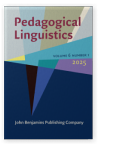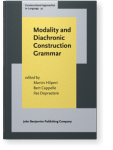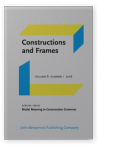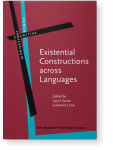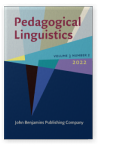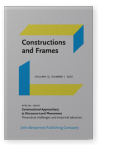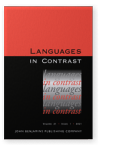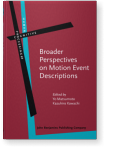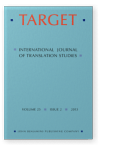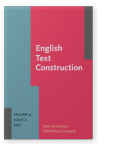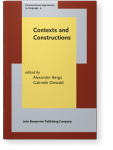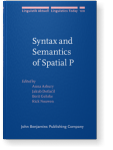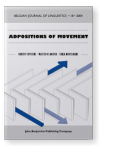Bert Cappelle
List of John Benjamins publications for which Bert Cappelle plays a role.
Journal
Titles
Modality and Diachronic Construction Grammar
Edited by Martin Hilpert, Bert Cappelle and Ilse Depraetere
[Constructional Approaches to Language, 32] 2021. v, 251 pp.
Subjects Historical linguistics | Semantics | Syntax | Theoretical linguistics
Modal Meaning in Construction Grammar
Edited by Bert Cappelle and Ilse Depraetere
Special issue of Constructions and Frames 8:1 (2016) vi, 129 pp.
Subjects Cognition and language | Functional linguistics | Syntax | Theoretical linguistics
2023 Chapter 11. Words also exist in a world: On the pattern ‘X’ does not exist; it’s called ‘Y’ Existential Constructions across Languages: Forms, meanings and functions, Sarda, Laure and Ludovica Lena (eds.), pp. 325–345 | Chapter
Clause sequences of the type ‘X’ does not exist – its correct name is ‘Y’ use descriptive negation in the first clause but also have something literally contradictory about them that is reminiscent of metalinguistic negation. I argue that the negative existential in such clause sequences… read more
2021 Not-fragments and negative expansion Constructional Approach(es) to Discourse-Level Phenomena: Theoretical challenges and empirical advances, Enghels, Renata and María Sol Sansiñena (eds.), pp. 55–81 | Article
This paper focuses on emphatic sentence fragments of the type Not in a million years!. While such fragments can be partially accounted for by a known type of ellipsis, namely ‘stripping’ , it is argued here that this type is best treated as a construction in its own right, with formal, semantic… read more
2021 Temperaments, tempers, and temporality: Constructions reveal how speakers of French and English conceptualize human properties Languages in Contrast 21:1, pp. 82–111 | Article
This study focuses on French and English abstract nouns denoting properties that can be ascribed to humans, such as beauty, carefulness and anger. Previous research showed that some but not all of these nouns are licensed in both locative existentials (e.g., There’s an intense anger in Isabella)… read more
2021 Modality in Diachronic Construction Grammar: Long-standing questions, new perspectives Modality and Diachronic Construction Grammar, Hilpert, Martin, Bert Cappelle and Ilse Depraetere (eds.), pp. 1–11 | Chapter
2020 Chapter 8. Looking into visual motion expressions in Dutch, English, and French: How languages stick to well-trodden typological paths Broader Perspectives on Motion Event Descriptions, Matsumoto, Yo and Kazuhiro Kawachi (eds.), pp. 235–280 | Chapter
This study investigates visual motion expressions in Dutch, English, and French. As a translation corpus, I use Roald Dahl’s children’s book The Witches, which abounds in staring and peeping events, and its Dutch and French translations. Based on the hypothesis that languages’ constructional… read more
2019 The necessity modals have to, must, need to, and should: Using n-grams to help identify common and distinct semantic and pragmatic aspects On the Role of Pragmatics in Construction Grammar, Finkbeiner, Rita (ed.), pp. 220–243 | Article
When an ambiguous lexical item appears within a familiar string of words, it can instantly receive an appropriate interpretation from this context, thus being saturated by it. Such a context may also short-circuit illocutionary and other pragmatic aspects of interpretation. We here extract from… read more
2016 Short-circuited interpretations of modal verb constructions: Some evidence from The Simpsons Modal Meaning in Construction Grammar, Cappelle, Bert and Ilse Depraetere (eds.), pp. 7–39 | Article
In this paper we aim to show how distinct semantic and pragmatic layers of modal interpretation can be fruitfully integrated within a constructionist approach. We discuss in detail a number of cases from the Simpsons where a modal verb, as part of a longer expression, has a short-circuited… read more
2016 Modal meaning in Construction Grammar Modal Meaning in Construction Grammar, Cappelle, Bert and Ilse Depraetere (eds.), pp. 1–6 | Article
2016 Response to Hilpert Modal Meaning in Construction Grammar, Cappelle, Bert and Ilse Depraetere (eds.), pp. 86–96 | Article
2013 Is there interference of usage constraints? A frequency study of existential there is and its French equivalent il y a in translated vs. non-translated texts Target 25:2, pp. 252–275 | Article
We examine the possible impact of frequency differences between a construction in L1 and its equivalent in L2 on translations. Our case is that of existential there in English and existential il y a in French. Using corpus evidence, we first confirm previous claims that existential there is used… read more
2011 Review of House (2009): Translation English Text Construction 4:2, pp. 310–314 | Review
2009 Contextual cues for particle placement: Multiplicity, motivation, modeling Contexts and Constructions, Bergs, Alexander and Gabriele Diewald (eds.), pp. 145–192 | Article
2008 The grammar of complex particle phrases in English Syntax and Semantics of Spatial P, Asbury, Anna, Jakub Dotlačil, Berit Gehrke and Rick Nouwen (eds.), pp. 103–145 | Article
2004 The Particularity of Particles, or Why They Are Not Just ‘Intransitive Prepositions’ Adpositions of Movement, Cuyckens, Hubert, Walter De Mulder and Tanja Mortelmans (eds.), pp. 29–57 | Article
Although the distinction between verb-preposition combinations (e.g., They fought over the money) and prima facie similar transitive verb-particle combinations (e.g., They handed over the money) is well known, some grammarians have taken the view that particles are in fact a sort of prepositions… read more
